Get free scan and check if your device is infected.
Remove it nowTo use full-featured product, you have to purchase a license for Combo Cleaner. Seven days free trial available. Combo Cleaner is owned and operated by RCS LT, the parent company of PCRisk.com.
What kind of application is CommonFunction?
We have classified CommonFunction as adware and found that it is flagged as malicious by security vendors. It delivers intrusive ads that can direct users to potentially harmful websites. Due to these factors, this application should not be trusted and must be removed if found on a system.
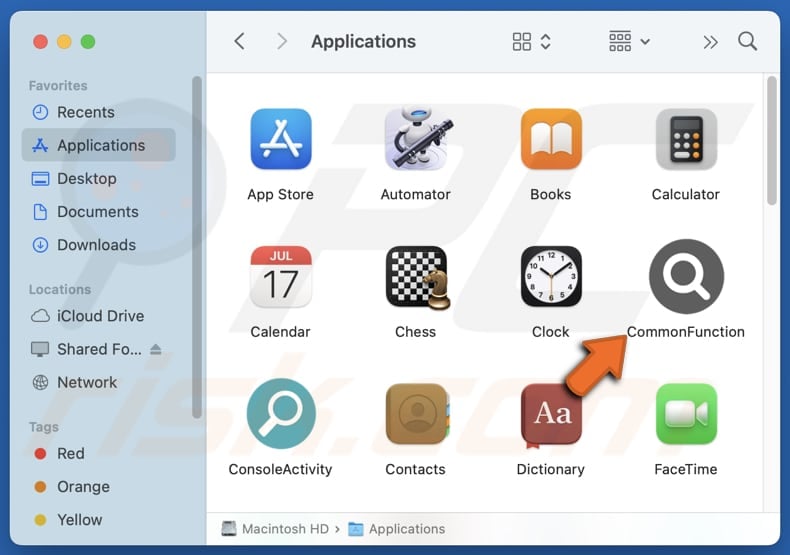
CommonFunction adware in detail
CommonFunction can flood users with intrusive ads, including banners, coupons, and pop-ups. These may push fake software updates, investment schemes, deceptive social media messages, or other misleading content. Clicking on these ads can lead users to untrustworthy websites hosting various scams and unwanted (potentially malicious) software.
For instance, these ads may promote technical support scams, fake lotteries, giveaways, other adware, browser hijackers, or even malware. Users may be deceived into transferring money to scammers (e.g., paying for fake products or services) or providing them remote access to computers. Also, users may unintentionally download malicious apps.
Moreover, ads from CommonFunction can take users to sites designed to steal login credentials, credit card details, ID card information, social security numbers, etc. It is highly advisable not to trust these ads, as this could lead to identity theft, monetary loss, computer infections, and other problems.
CommonFunction may also stealthily collect personal data, including browsing history, names, and email addresses, which can be shared or sold to third parties for exploitation. In addition, it might alter browser settings to redirect users to dubious websites, such as fake search engines. Due to these risks, users should avoid installing the app and remove it immediately if detected.
If manual removal does not work, a trusted security tool like Combo Cleaner can assist in fully eliminating CommonFunction.
| Name | Ads by CommonFunction |
| Threat Type | Adware, Mac malware, Mac virus |
| Detection Names | Avast (MacOS:Adload-AG [Adw]), Combo Cleaner (Gen:Variant.Adware.MAC.AdLoad.13), ESET-NOD32 (A Variant Of OSX/Adware.Synataeb.G), Kaspersky (Not-a-virus:HEUR:AdWare.OSX.Adload.h), Full List (VirusTotal) |
| Additional Information | This application belongs to Adload malware family. |
| Symptoms | Your Mac becomes slower than normal, you see unwanted pop-up ads, you are redirected to dubious websites. |
| Distribution methods | Deceptive pop-up ads, free software installers (bundling), torrent file downloads. |
| Damage | Internet browser tracking (potential privacy issues), display of unwanted ads, redirects to dubious websites, loss of private information. |
| Malware Removal (Windows) |
To eliminate possible malware infections, scan your computer with legitimate antivirus software. Our security researchers recommend using Combo Cleaner. Download Combo CleanerTo use full-featured product, you have to purchase a license for Combo Cleaner. 7 days free trial available. Combo Cleaner is owned and operated by RCS LT, the parent company of PCRisk.com. |
Conclusion
Adware like CommonFunction disrupts browsing with intrusive ads and may expose users to scams or malicious sites. It can also collect personal data without consent. To stay safe, users should avoid installing such programs and remove them with a trusted security tool if necessary.
More adware examples are DynamicSector, OpticalNavigation, and ManagerInterface.
How did CommonFunction install on my computer?
Users often install adware together with free or untrustworthy software when they skip through setup options without checking “Advanced” or “Custom” settings or unticking checkboxes (without rejecting unwanted offers included in installers).
Also, users can unintentionally download and install adware when using P2P networks, third-party downloaders, unofficial web pages (or app stores), and similar sources. Additionally, adware can be distributed through fake software updates, misleading ads, suspicious links, and deceptive notifications.
How to avoid installation of unwanted applications?
When installing software, choose “Custom”, “Advanced”, or similar options to reject offers to install unwanted apps. Download apps and files only from official app stores or websites. Keep your system and applications up to date. Do not agree to receive notifications from unreliable sites.
Avoid clicking ads, pop-ups, or suspicious links on untrustworthy websites. Regularly scan your system with reputable security software and keep it up to date. If your computer is already infected with CommonFunction, we recommend running a scan with Combo Cleaner Antivirus for Windows to automatically eliminate this adware.
A message that appears after the installation of CommonFunction:
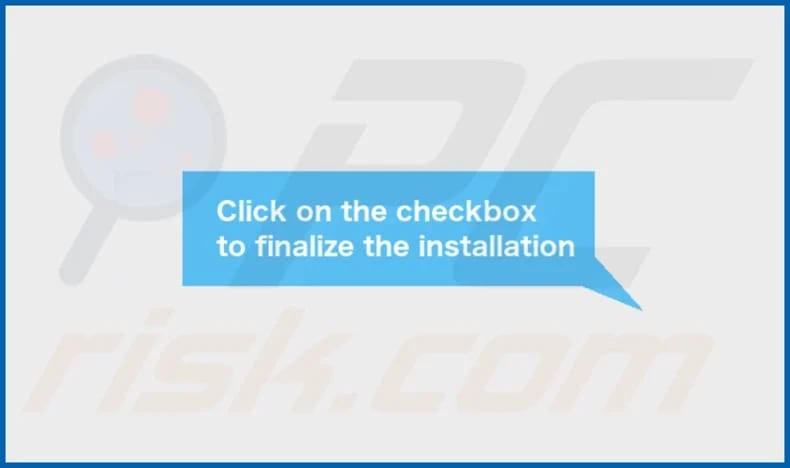
CommonFunction installation folder:
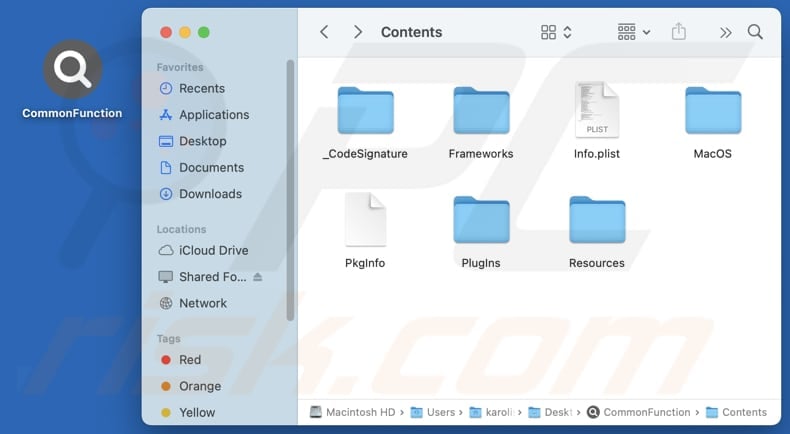
Instant automatic malware removal:
Manual threat removal might be a lengthy and complicated process that requires advanced IT skills. Combo Cleaner is a professional automatic malware removal tool that is recommended to get rid of malware. Download it by clicking the button below:
DOWNLOAD Combo CleanerBy downloading any software listed on this website you agree to our Privacy Policy and Terms of Use. To use full-featured product, you have to purchase a license for Combo Cleaner. 7 days free trial available. Combo Cleaner is owned and operated by RCS LT, the parent company of PCRisk.com.
Quick menu:
- What is CommonFunction?
- STEP 1. Remove CommonFunction related files and folders from OSX.
- STEP 2. Remove CommonFunction ads from Safari.
- STEP 3. Remove CommonFunction adware from Google Chrome.
- STEP 4. Remove CommonFunction ads from Mozilla Firefox.
Video showing how to remove adware and browser hijackers from a Mac computer:
CommonFunction adware removal:
Remove CommonFunction-related potentially unwanted applications from your "Applications" folder:
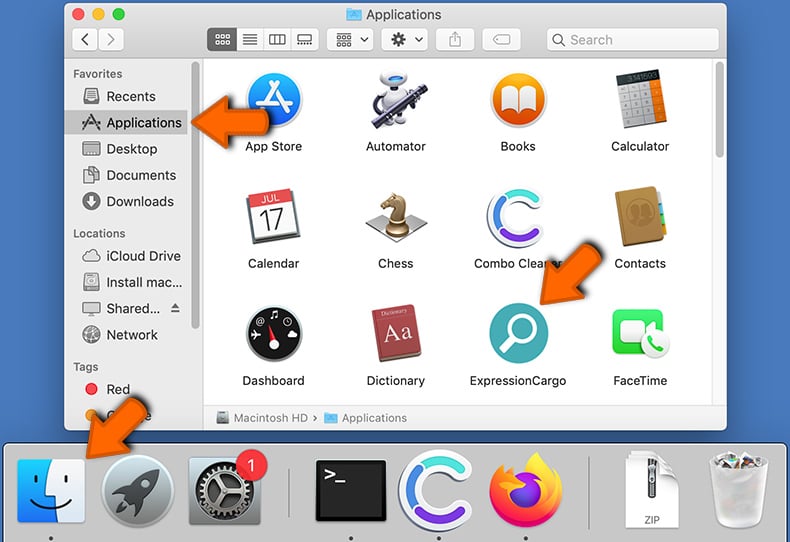
Click the Finder icon. In the Finder window, select "Applications". In the applications folder, look for "MPlayerX", "NicePlayer", or other suspicious applications and drag them to the Trash. After removing the potentially unwanted application(s) that cause online ads, scan your Mac for any remaining unwanted components.
DOWNLOAD remover for malware infections
Combo Cleaner checks if your computer is infected with malware. To use full-featured product, you have to purchase a license for Combo Cleaner. 7 days free trial available. Combo Cleaner is owned and operated by RCS LT, the parent company of PCRisk.com.
Remove adware-related files and folders
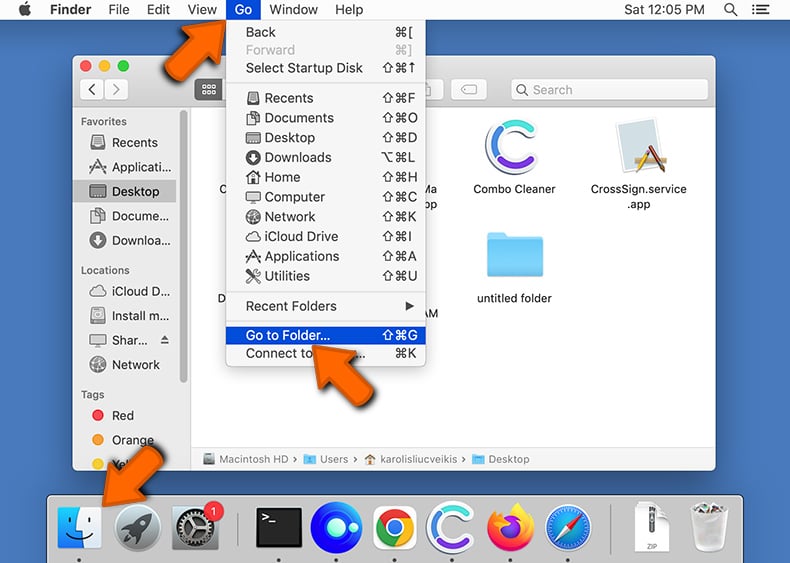
Click the Finder icon, from the menu bar. Choose Go, and click Go to Folder...
 Check for adware generated files in the /Library/LaunchAgents/ folder:
Check for adware generated files in the /Library/LaunchAgents/ folder:
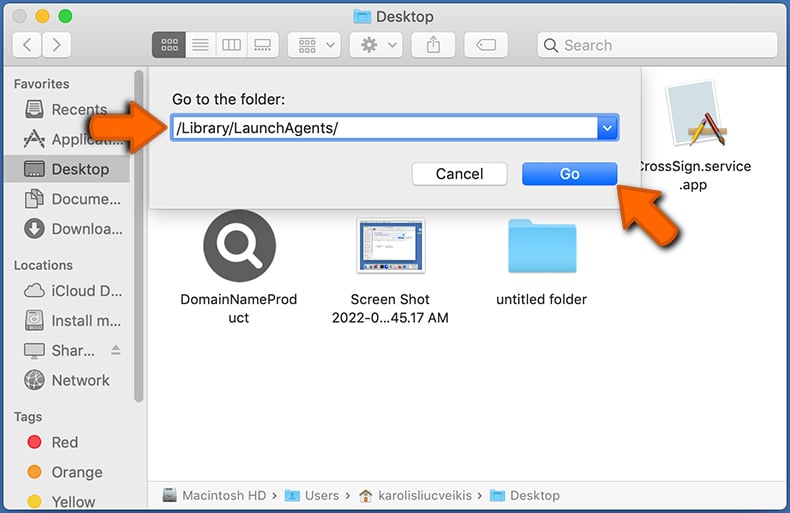
In the Go to Folder... bar, type: /Library/LaunchAgents/
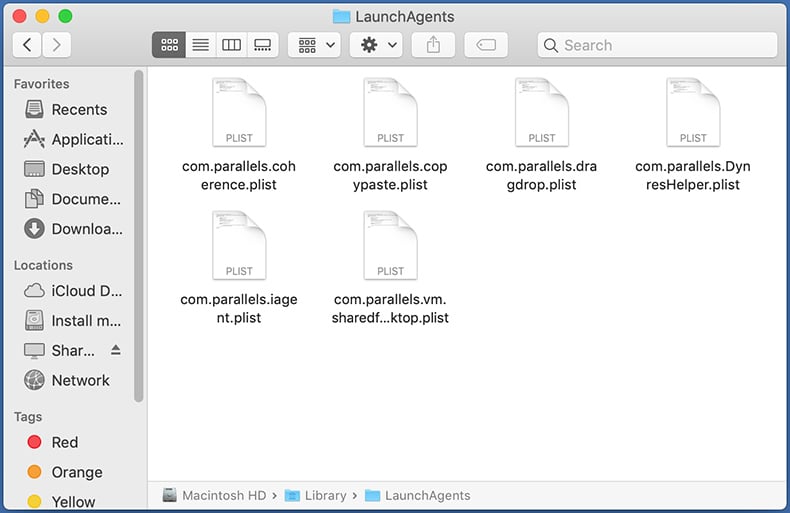
In the "LaunchAgents" folder, look for any recently-added suspicious files and move them to the Trash. Examples of files generated by adware - "installmac.AppRemoval.plist", "myppes.download.plist", "mykotlerino.ltvbit.plist", "kuklorest.update.plist", etc. Adware commonly installs several files with the exact same string.
 Check for adware generated files in the ~/Library/Application Support/ folder:
Check for adware generated files in the ~/Library/Application Support/ folder:
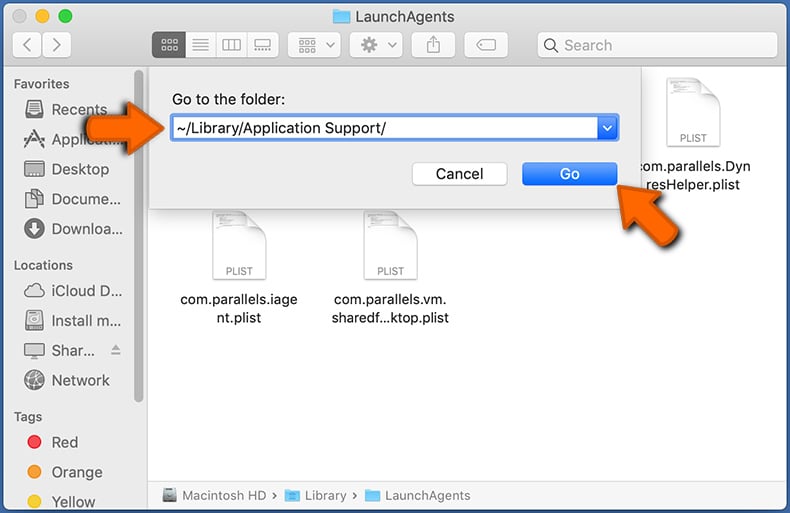
In the Go to Folder... bar, type: ~/Library/Application Support/
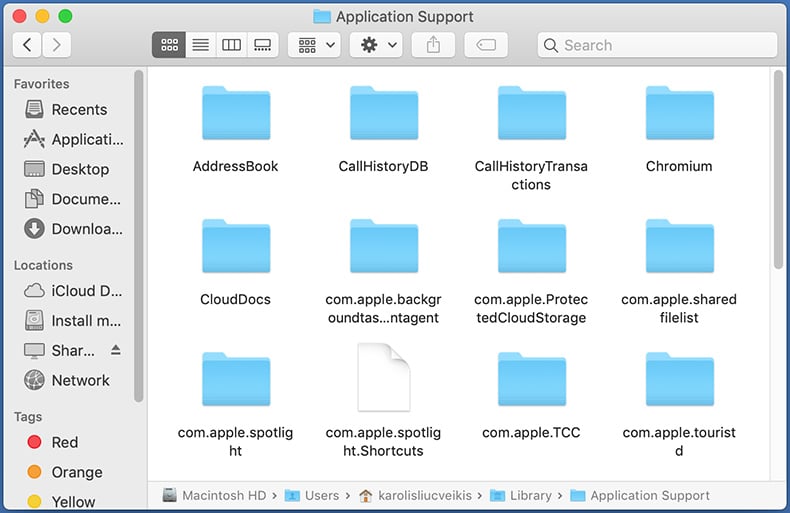
In the "Application Support" folder, look for any recently-added suspicious folders. For example, "MplayerX" or "NicePlayer", and move these folders to the Trash.
 Check for adware generated files in the ~/Library/LaunchAgents/ folder:
Check for adware generated files in the ~/Library/LaunchAgents/ folder:
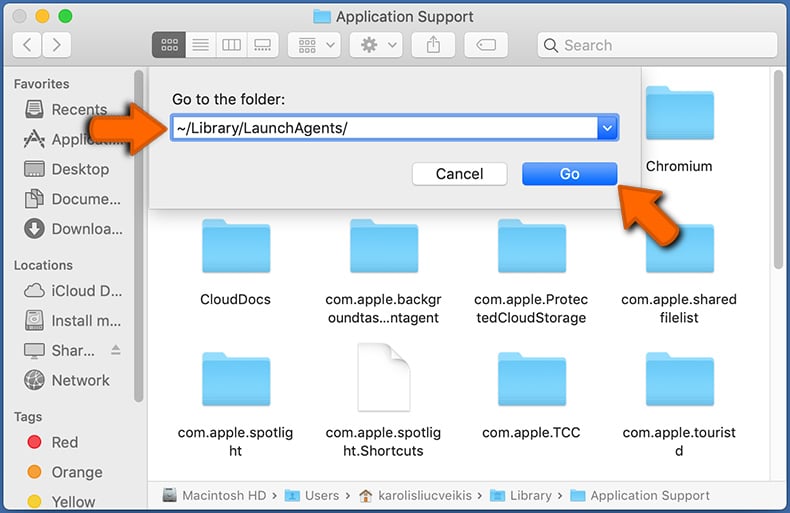
In the Go to Folder... bar, type: ~/Library/LaunchAgents/
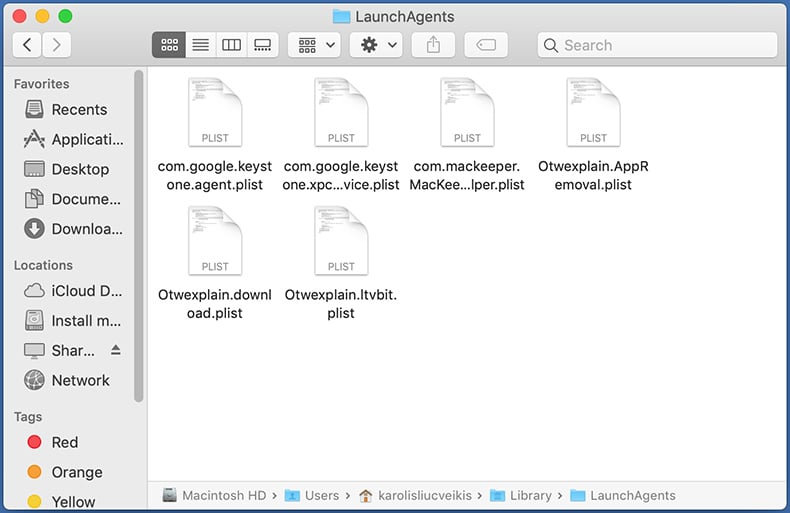
In the "LaunchAgents" folder, look for any recently-added suspicious files and move them to the Trash. Examples of files generated by adware - "installmac.AppRemoval.plist", "myppes.download.plist", "mykotlerino.ltvbit.plist", "kuklorest.update.plist", etc. Adware commonly installs several files with the exact same string.
 Check for adware generated files in the /Library/LaunchDaemons/ folder:
Check for adware generated files in the /Library/LaunchDaemons/ folder:
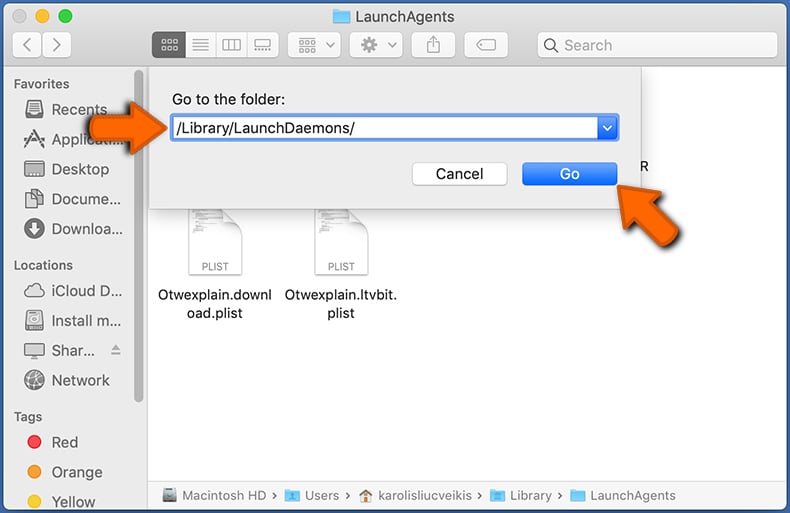
In the "Go to Folder..." bar, type: /Library/LaunchDaemons/
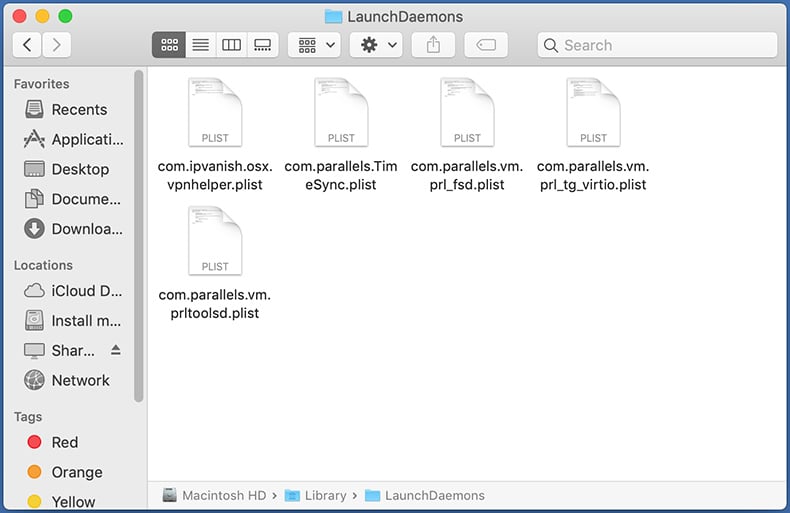
In the "LaunchDaemons" folder, look for recently-added suspicious files. For example "com.aoudad.net-preferences.plist", "com.myppes.net-preferences.plist", "com.kuklorest.net-preferences.plist", "com.avickUpd.plist", etc., and move them to the Trash.
 Scan your Mac with Combo Cleaner:
Scan your Mac with Combo Cleaner:
If you have followed all the steps correctly, your Mac should be clean of infections. To ensure your system is not infected, run a scan with Combo Cleaner Antivirus. Download it HERE. After downloading the file, double click combocleaner.dmg installer. In the opened window, drag and drop the Combo Cleaner icon on top of the Applications icon. Now open your launchpad and click on the Combo Cleaner icon. Wait until Combo Cleaner updates its virus definition database and click the "Start Combo Scan" button.
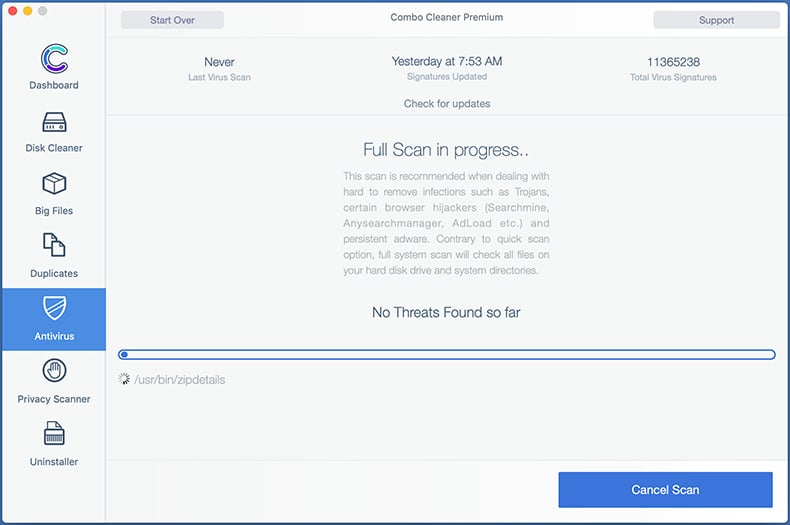
Combo Cleaner will scan your Mac for malware infections. If the antivirus scan displays "no threats found" - this means that you can continue with the removal guide; otherwise, it's recommended to remove any found infections before continuing.
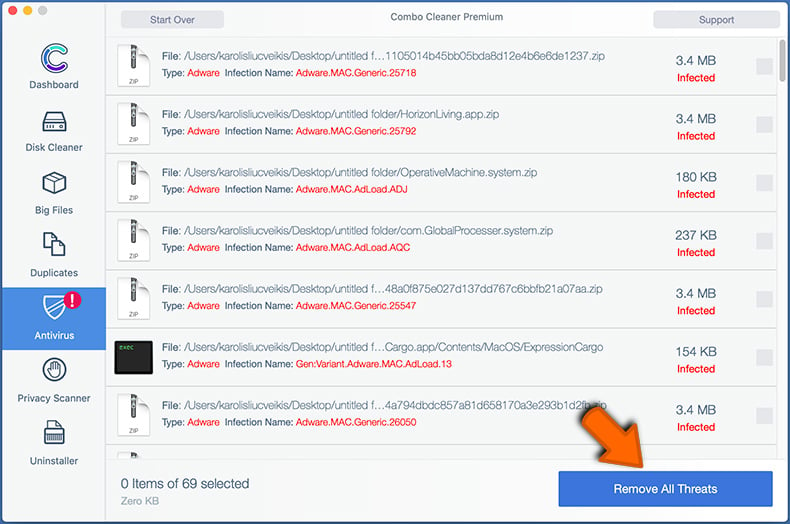
After removing files and folders generated by the adware, continue to remove rogue extensions from your Internet browsers.
Remove malicious extensions from Internet browsers
 Remove malicious Safari extensions:
Remove malicious Safari extensions:
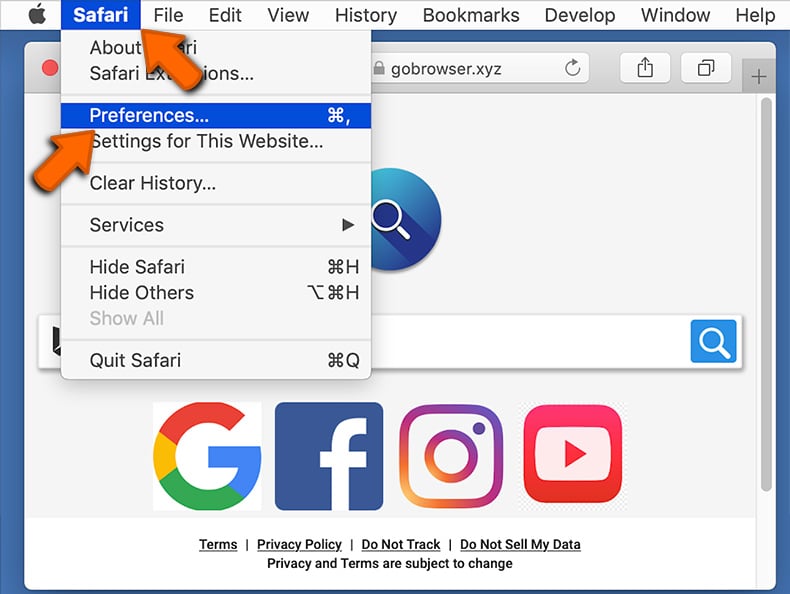
Open the Safari browser, from the menu bar, select "Safari" and click "Preferences...".
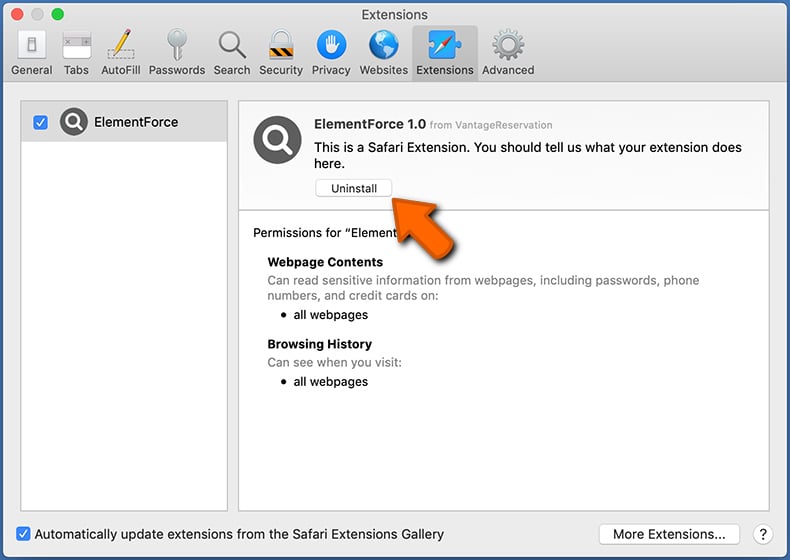
In the preferences window, select "Extensions" and look for any recently-installed suspicious extensions. When located, click the "Uninstall" button next to it/them. Note that you can safely uninstall all extensions from your Safari browser - none are crucial for regular browser operation.
- If you continue to have problems with browser redirects and unwanted advertisements - Reset Safari.
 Remove malicious extensions from Google Chrome:
Remove malicious extensions from Google Chrome:
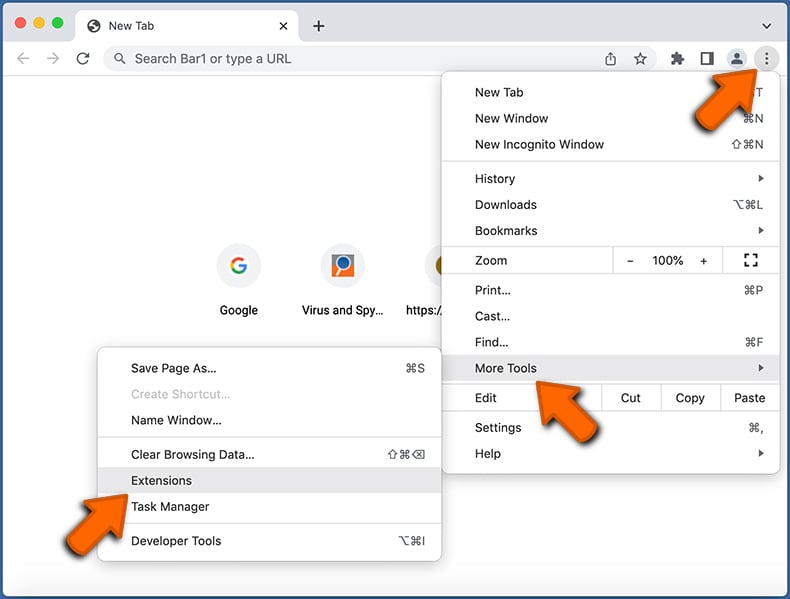
Click the Chrome menu icon ![]() (at the top right corner of Google Chrome), select "More Tools" and click "Extensions". Locate all recently-installed suspicious extensions, select these entries and click "Remove".
(at the top right corner of Google Chrome), select "More Tools" and click "Extensions". Locate all recently-installed suspicious extensions, select these entries and click "Remove".
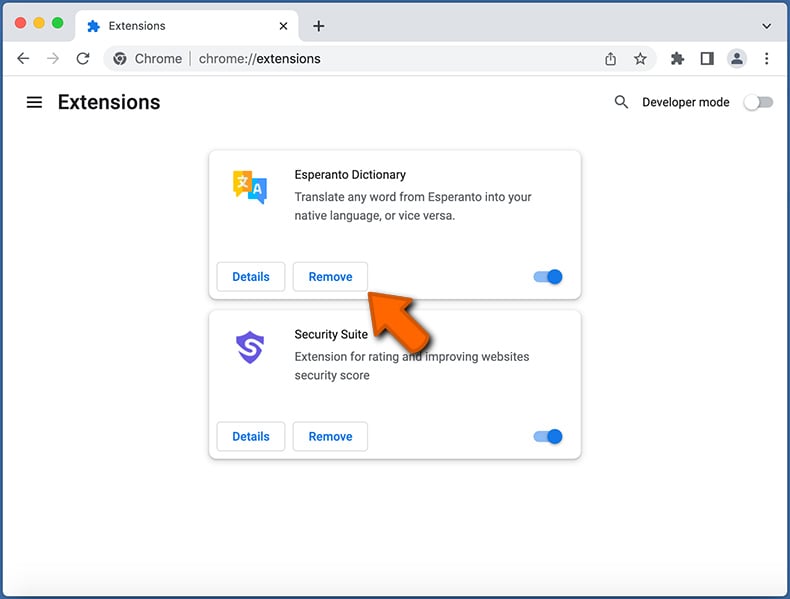
- If you continue to have problems with browser redirects and unwanted advertisements - Reset Google Chrome.
 Remove malicious extensions from Mozilla Firefox:
Remove malicious extensions from Mozilla Firefox:
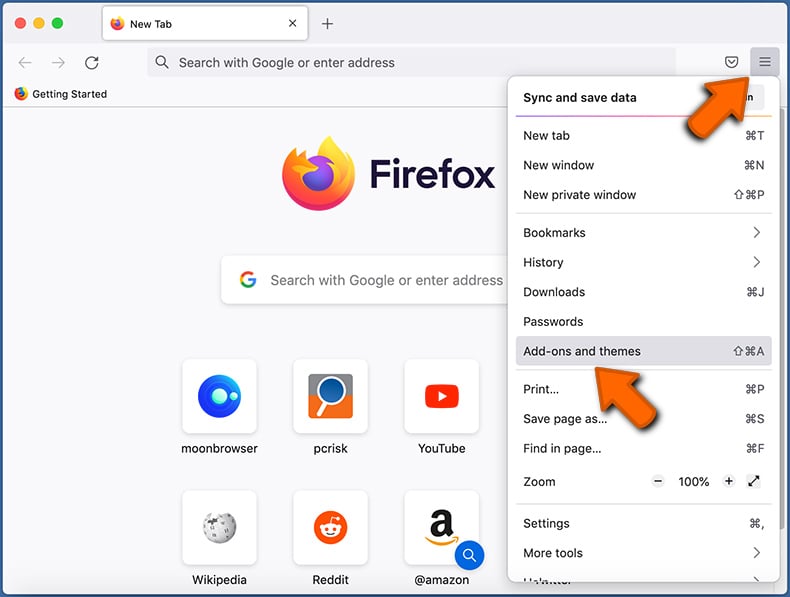
Click the Firefox menu ![]() (at the top right corner of the main window) and select "Add-ons and themes". Click "Extensions", in the opened window locate all recently-installed suspicious extensions, click on the three dots and then click "Remove".
(at the top right corner of the main window) and select "Add-ons and themes". Click "Extensions", in the opened window locate all recently-installed suspicious extensions, click on the three dots and then click "Remove".
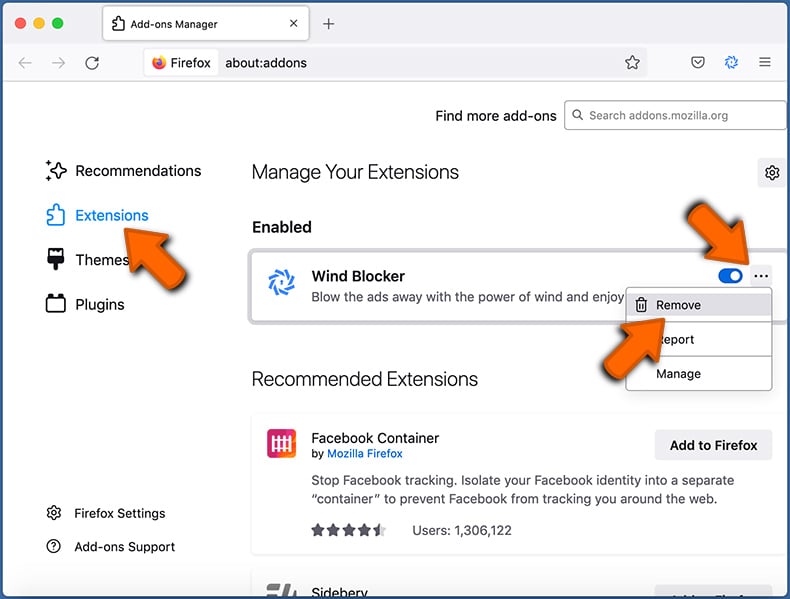
- If you continue to have problems with browser redirects and unwanted advertisements - Reset Mozilla Firefox.
Frequently Asked Questions (FAQ)
What harm can adware cause?
This software can negatively impact the user experience, degrade system performance, and expose users to security and privacy threats.
What does adware do?
Typically, adware's primary function is to display ads. It can also gather personal data and hijack browsers (by changing their settings).
How do adware developers generate revenue?
Adware developers generally profit by displaying ads and promoting products or services via affiliate programs. They receive commissions when users interact with the ads, click links, or complete purchases.
Will Combo Cleaner remove CommonFunction adware?
Combo Cleaner is highly effective at detecting and removing adware and unwanted software. It is worth noting that manual methods may miss hidden files. Combo Cleaner ensures the system is fully cleaned.
Share:

Tomas Meskauskas
Expert security researcher, professional malware analyst
I am passionate about computer security and technology. I have an experience of over 10 years working in various companies related to computer technical issue solving and Internet security. I have been working as an author and editor for pcrisk.com since 2010. Follow me on Twitter and LinkedIn to stay informed about the latest online security threats.
PCrisk security portal is brought by a company RCS LT.
Joined forces of security researchers help educate computer users about the latest online security threats. More information about the company RCS LT.
Our malware removal guides are free. However, if you want to support us you can send us a donation.
DonatePCrisk security portal is brought by a company RCS LT.
Joined forces of security researchers help educate computer users about the latest online security threats. More information about the company RCS LT.
Our malware removal guides are free. However, if you want to support us you can send us a donation.
Donate
▼ Show Discussion